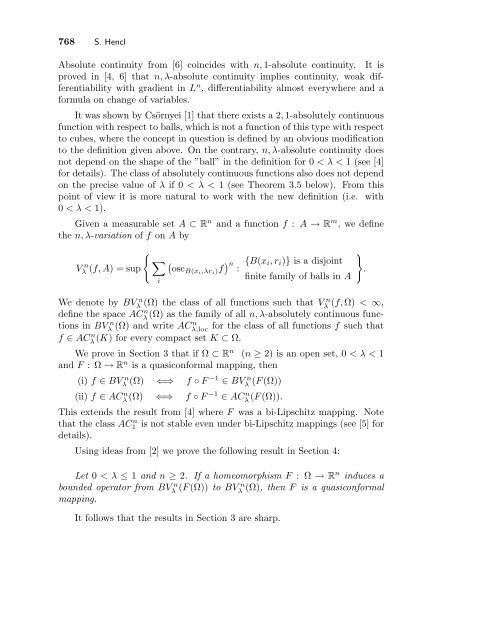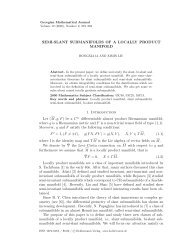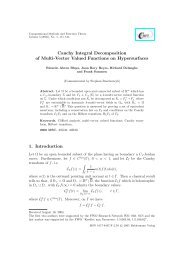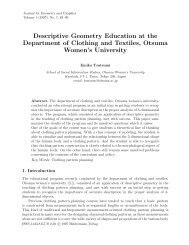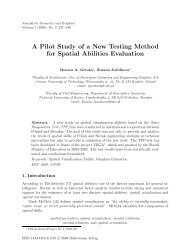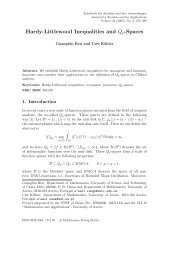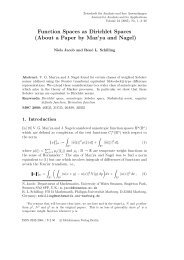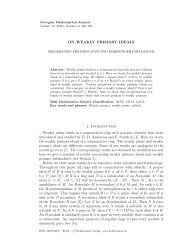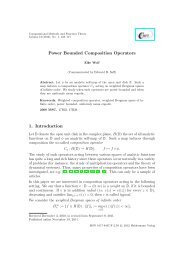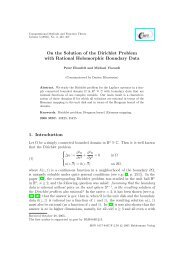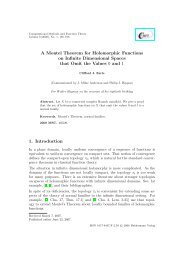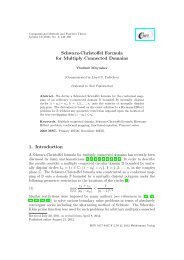Absolute continuity for functions of several variables - Heldermann ...
Absolute continuity for functions of several variables - Heldermann ...
Absolute continuity for functions of several variables - Heldermann ...
Create successful ePaper yourself
Turn your PDF publications into a flip-book with our unique Google optimized e-Paper software.
768 S. Hencl<br />
<strong>Absolute</strong> <strong>continuity</strong> from [6] coincides with n, 1-absolute <strong>continuity</strong>. It is<br />
proved in [4, 6] that n, λ-absolute <strong>continuity</strong> implies <strong>continuity</strong>, weak differentiability<br />
with gradient in L n , differentiability almost everywhere and a<br />
<strong>for</strong>mula on change <strong>of</strong> <strong>variables</strong>.<br />
It was shown by Csörnyei [1] that there exists a 2, 1-absolutely continuous<br />
function with respect to balls, which is not a function <strong>of</strong> this type with respect<br />
to cubes, where the concept in question is defined by an obvious modification<br />
to the definition given above. On the contrary, n, λ-absolute <strong>continuity</strong> does<br />
not depend on the shape <strong>of</strong> the ”ball” in the definition <strong>for</strong> 0 < λ < 1 (see [4]<br />
<strong>for</strong> details). The class <strong>of</strong> absolutely continuous <strong>functions</strong> also does not depend<br />
on the precise value <strong>of</strong> λ if 0 < λ < 1 (see Theorem 3.5 below). From this<br />
point <strong>of</strong> view it is more natural to work with the new definition (i.e. with<br />
0 < λ < 1).<br />
Given a measurable set A ⊂ R n and a function f : A → R m , we define<br />
the n, λ-variation <strong>of</strong> f on A by<br />
V n λ (f, A) = sup<br />
{ ∑<br />
i<br />
(<br />
oscB(xi ,λr i )f ) n<br />
:<br />
{B(x i , r i )} is a disjoint<br />
finite family <strong>of</strong> balls in A<br />
We denote by BVλ n(Ω) the class <strong>of</strong> all <strong>functions</strong> such that V λ n (f, Ω) < ∞,<br />
define the space ACλ n (Ω) as the family <strong>of</strong> all n, λ-absolutely continuous <strong>functions</strong><br />
in BVλ n(Ω) and write ACn λ,loc<br />
<strong>for</strong> the class <strong>of</strong> all <strong>functions</strong> f such that<br />
f ∈ ACλ n (K) <strong>for</strong> every compact set K ⊂ Ω.<br />
We prove in Section 3 that if Ω ⊂ R n (n ≥ 2) is an open set, 0 < λ < 1<br />
and F : Ω → R n is a quasicon<strong>for</strong>mal mapping, then<br />
(i) f ∈ BVλ n(Ω) ⇐⇒ f ◦ F −1 ∈ BVλ n (F (Ω))<br />
(ii) f ∈ ACλ n(Ω) ⇐⇒ f ◦ F −1 ∈ ACλ n (F (Ω)).<br />
This extends the result from [4] where F was a bi-Lipschitz mapping. Note<br />
that the class AC1<br />
n is not stable even under bi-Lipschitz mappings (see [5] <strong>for</strong><br />
details).<br />
Using ideas from [2] we prove the following result in Section 4:<br />
Let 0 < λ ≤ 1 and n ≥ 2. If a homeomorphism F : Ω → R n induces a<br />
bounded operator from BVλ n(F (Ω)) to BV λ n (Ω), then F is a quasicon<strong>for</strong>mal<br />
mapping.<br />
It follows that the results in Section 3 are sharp.<br />
}<br />
.


